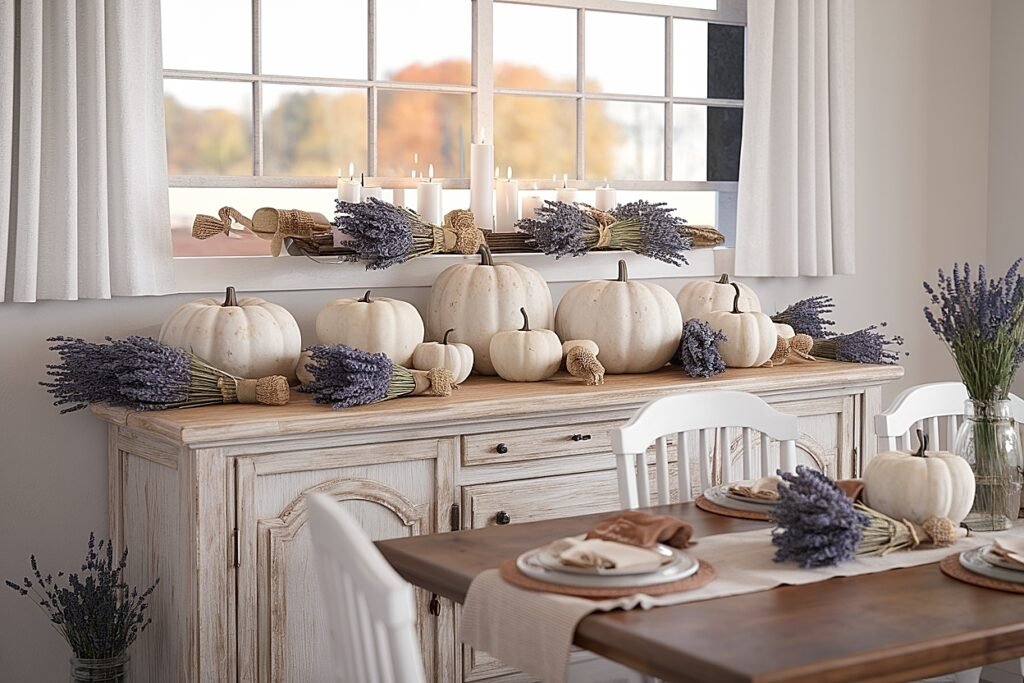
This website contains affiliate links, and some products are gifted by the brand to test. As an Amazon Associate, I earn from qualified purchases. Some of the content on this website was researched and created with the assistance of AI technology.
Key Takeaways
- Build from the surface up: a matte runner for traction, low greenery for structure, then disciplined lavender accents for aroma and line.
- Keep heights staggered but conversational—anchors at 8–12 inches, support under 6 inches—so trays, dishes, and hands move freely.
- Repeat one palette and one metal across the room to unite table, sideboard, and windows; edit mercilessly to avoid clutter.
Styling Thanksgiving Sideboards with Lavender Accents starts with a simple goal: create a calm, fragrant service zone that looks intentional and never competes with the dining table. Lavender adds breath and elegance to a space that’s usually all platters and chaos. When you place it with purpose—short, wired bundles; clean mechanics; consistent palette—the sideboard becomes the quiet backbone of the room.
I’ve styled sideboards in tight apartments and sprawling farmhouses, and the wins stay the same: keep sightlines open, protect the surface, and repeat materials from the table so the entire room reads as one idea. Lavender delivers scent and line without volume, which is exactly what a working sideboard needs.
Quick scan: Pick a topic, follow the placement cues, and tick the quick wins. Your lavender dining table stays cohesive with nearby windows, sideboards, hutches, and seating.
| Core Topic | What to Focus On | Windows & Furniture Cues | Quick Wins |
|---|---|---|---|
|
Core Topic
Centerpieces & Runners
BalanceGrounding
|
Focus
|
Placement
|
Quick Wins
|
|
Place Settings & Fabrics
CohesionClarity
|
|
|
|
|
Vessels & Structures
ClochesTraysGlass
|
|
|
|
|
Lighting & Reflections
GlowShimmer
|
|
|
|
|
Extensions & Guest Touches
FlowExperience
|
|
|
|
How to Layer Lavender and Pumpkins on Thanksgiving Sideboards
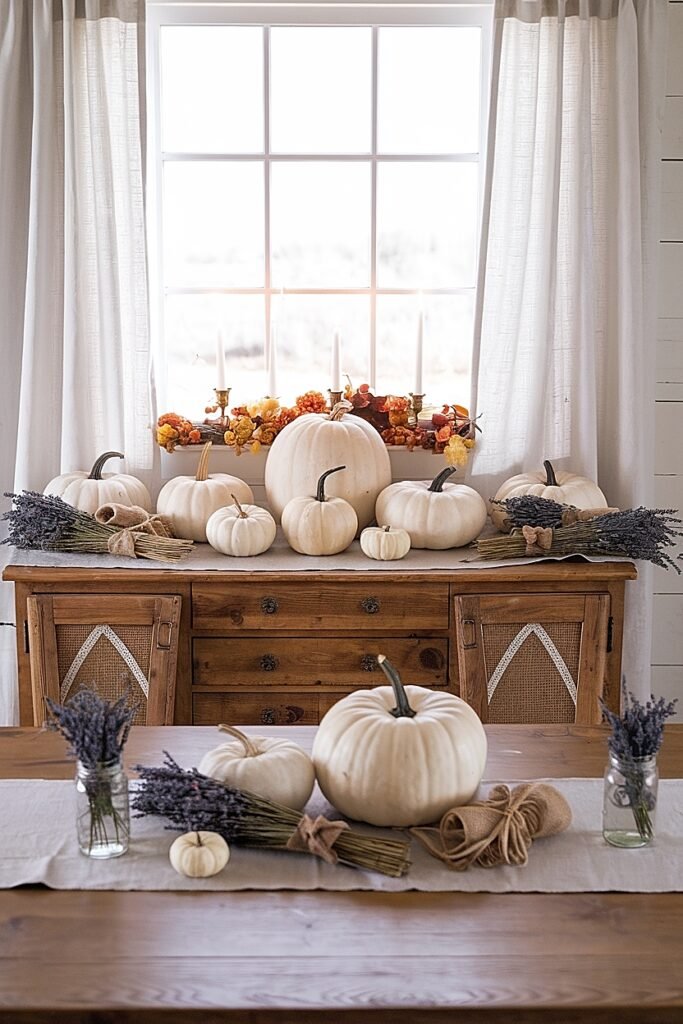
Sideboards are service-centered, so I build a landscape that looks lush and still leaves space for dishes. I start with a narrow, matte runner to stop sliding. Then I add a low bed of olive or seeded eucalyptus, keeping greens within the runner’s width so edges stay crisp. Pumpkins come next: one medium heirloom (Jarrahdale or Fairytale) as an anchor, plus a trio of minis to echo rhythm across the surface.
Lavender finishes the story. I wire 3–5 stem bundles at 4–5 inches and “stitch” them into the greenery at 45 degrees so they look grown-in, not sprinkled. Dusty miller pads soften transitions and mirror lavender’s cool bloom. If the room is drafty, I favor preserved stems for longevity.
Layer a matte runner, low greenery, one medium pumpkin, and minis; then tuck short, wired lavender bundles on angles to connect the composition. For a deeper dive into balancing the same elements at the table, see Lavender and Pumpkin Centerpieces for Rustic Thanksgiving—and if this helps, share it with friends who love a fragrant, calm holiday setup. More varietal nuance is up next—keep reading.
What Are the Best Lavender Varieties for Thanksgiving Sideboard Displays?
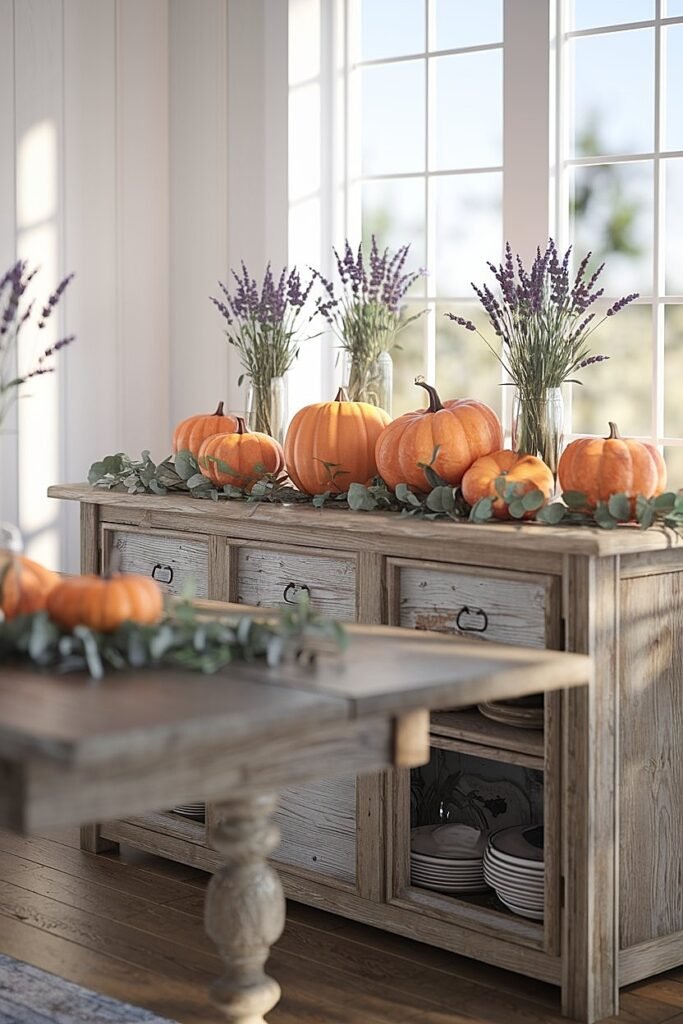
- English Lavender (Lavandula angustifolia): Compact buds, refined scent, and minimal shedding when handled gently. It excels in micro-bundles for collaring pumpkins and edging trays. Under candlelight, its dusky tone reads sophisticated rather than floral-forward, keeping focus on food and ceramics.
- Lavandin (Lavandula x intermedia): Longer stems with abundant buds—perfect for low garlands and slim rings under minis. It dries reliably and provides the “line” you need to pull the eye from anchor pumpkin to serving pieces. Aroma has a fresh lift that holds up in larger, bustling rooms.
- French/Spanish Lavender (Lavandula stoechas): Sculptural “rabbit ears” that deliver character in small doses. I use it as an accent near the visual focal (mirror or lamp) where its silhouette matters most. Keep it away from steaming dishes; the bracts dislike sustained humidity.
Use English for detail, Lavandin for structure, and Stoechas as a sculptural accent. More vessel tactics next—keep reading to put jars to work without crowding.
How to Arrange Lavender in Glass Jars on Thanksgiving Sideboards
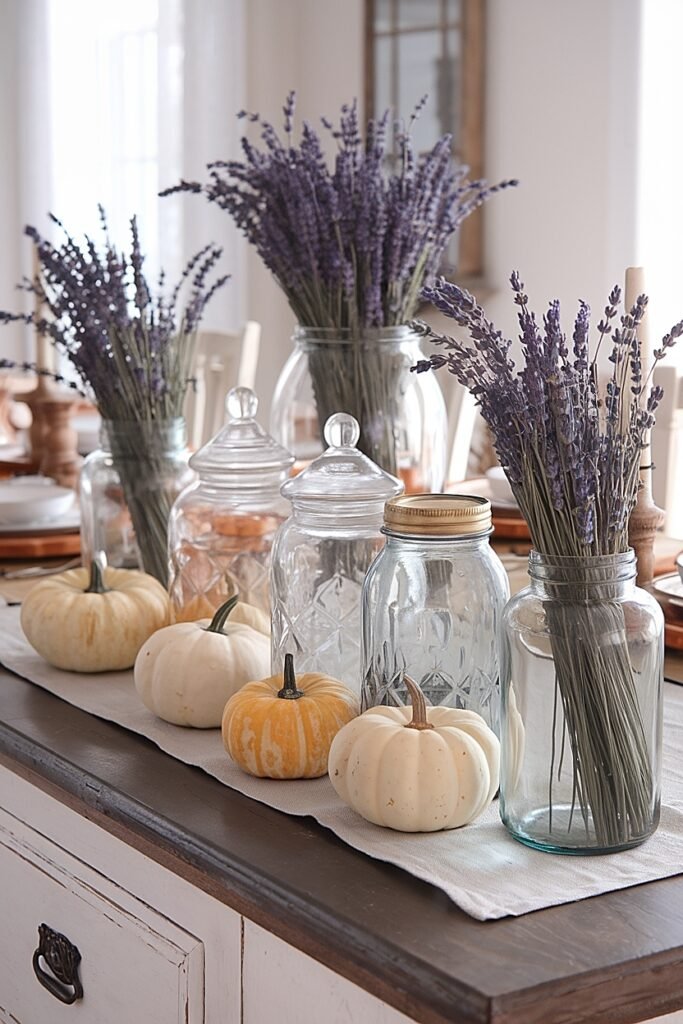
Glass jars are workhorses when you size and group them intentionally. I cluster three jars—tall, medium, small—on a tray to corral drips and keep movement predictable. I sleeve stems in narrow water tubes (if fresh) or keep them dry (if preserved), then cut stems short so blooms hover just above the rim. This creates a low, tailored silhouette that won’t snag sleeves.
For finish, I choose frosted, smoked, or clear glass depending on metal tone. A few olive leaves or dusty miller pads around the mouth hide mechanics. Place the cluster at one sideboard end to balance a medium pumpkin at the other; this asymmetric stance feels relaxed and editorial.
Group jars on a tray, cut stems short, and hide mechanics with silver-green leaves; park clusters opposite your pumpkin anchor for balance. More room cohesion next—keep reading to bridge table and sideboard gracefully.
Ways to Extend Lavender Thanksgiving Décor from Table to Sideboard
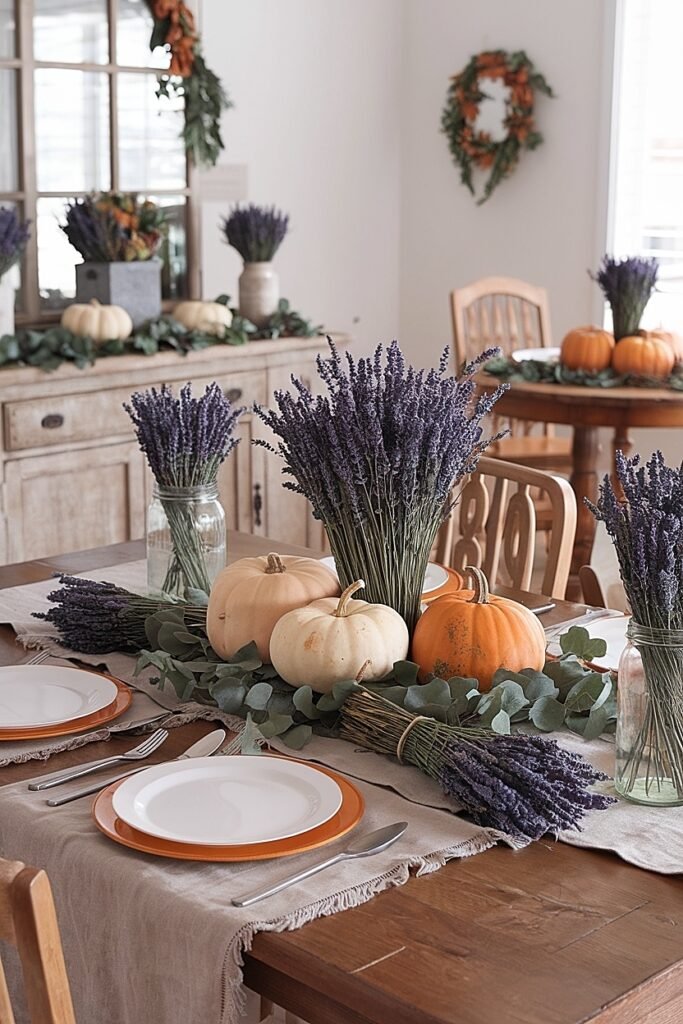
- Ribbon Continuity: Use the same velvet or linen ribbon on napkin ties and sideboard jar collars. This unifies color and texture without adding more florals, and it photographs as a throughline from seat to service.
- Metal Echo: If the table uses pewter chargers, mirror that finish in sideboard votive cups and jar lids. Consistent metal temperature keeps lavender’s cool hue crisp and prevents visual noise.
- Stem Signature: Pick one accent stem (juniper with berries, dusty miller, or olive) and repeat it lightly on the sideboard garland. It’s a quiet handshake between zones that makes the whole room hum in harmony.
Repeat one ribbon, one metal, and one accent stem across both surfaces to make the space feel composed. Runner choices are next—keep reading to select the right foundation.
What Are the Best Runners for Lavender Thanksgiving Sideboard Displays?
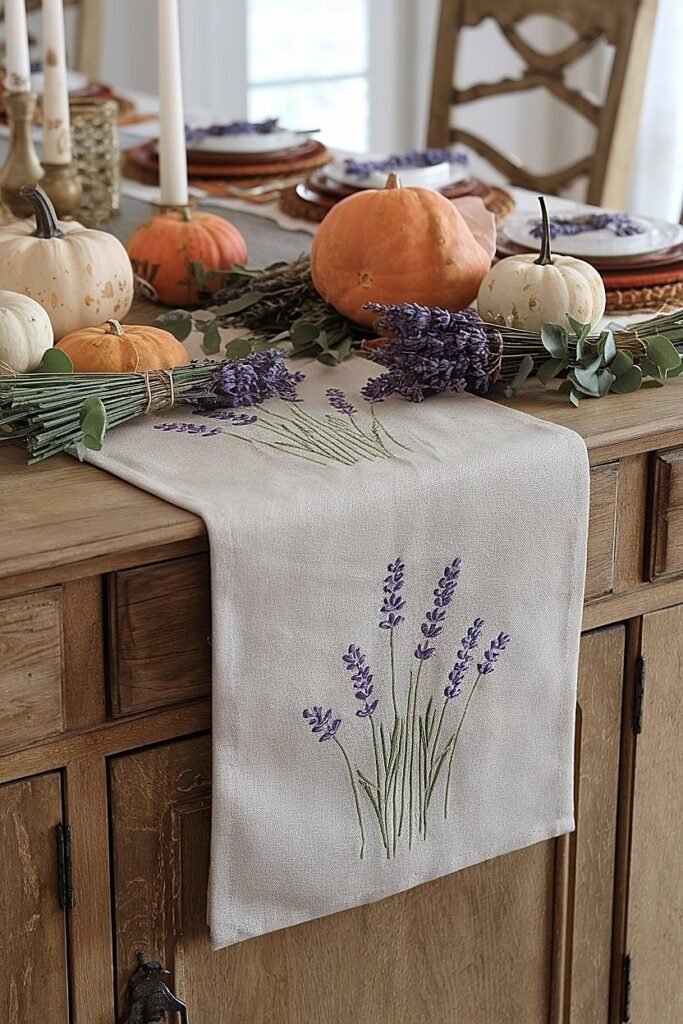
- Natural Linen (Bone): Matte, forgiving, and ideal for highlighting lavender’s dusty tone. Bone brightens dark wood and keeps the overall read airy. Spot-cleanable and timeless.
- Wool-Blend Felt (Charcoal): A graphic base that swallows glare from glass and metals. Charcoal frames pale pumpkins and silver-green foliage, creating museum-level contrast without fuss.
- Raw-Edge Cotton (Sage): Herbal and subtle, sage quietly bridges greens and lavender. Raw edges add rustic credibility while keeping the profile soft.
- Burlap with Backing: Texture-forward and practical, but choose a lined version so fibers don’t migrate into food zones. Works best with pewter and stoneware; pair with matte candles.
- Narrow Leather Strap Runner: For contemporary spaces, a 4–6 inch leather “track” under jars and a pumpkin adds polish and protects wood. Lavender pops against the warm, smooth surface.
Match runner texture to your room’s vibe, keep widths narrow for usable surface, and choose matte fabrics to flatter lavender. More sparkle control ahead—keep reading to work metals without glare.
How to Highlight Lavender with Metallic Accents on Thanksgiving Sideboards
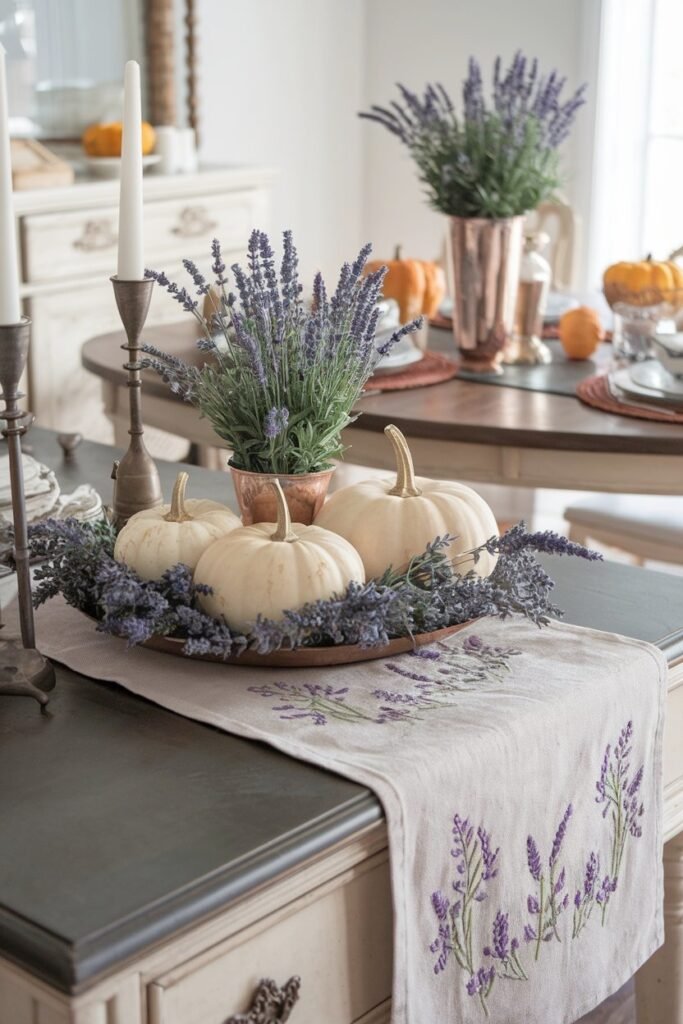
Metal is your amplifier. I pick one dominant finish—pewter for cool elegance, antique brass for warmth—and stick to it. Votives, trays, and tiny bells on ribbon tails repeat the choice without overwhelming the botanicals. For shimmer, mercury glass votives diffuse light and flatter faces while leaving lavender’s color intact.
Placement matters: set reflective pieces near, not behind, lavender bundles so the glow washes over buds instead of silhouetting them. If you have a wall mirror over the sideboard, angle one mercury cup to catch candlelight and bounce a soft halo across the arrangement.
Limit to one metal plus a secondary echo; place reflective items to wash light over lavender, not behind it. More appetite-forward styling next—keep reading to pair fruit with scent.
Ways to Combine Lavender with Seasonal Fruits on Thanksgiving Sideboards
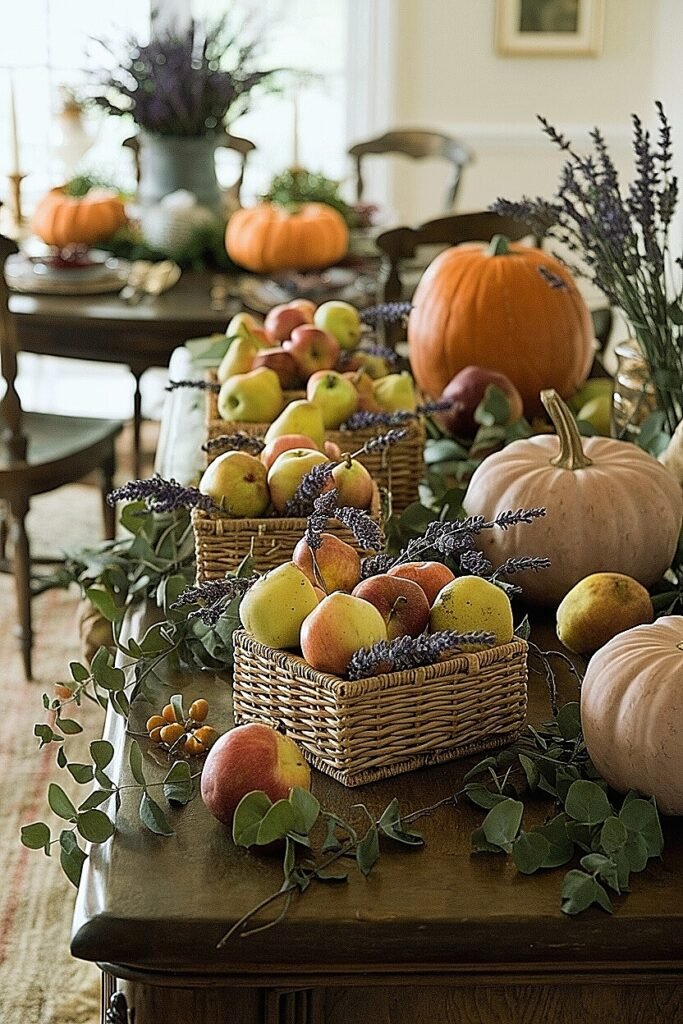
- Figs on Pewter Saucers: Halved figs bring depth and gloss that rhyme with lavender’s tone. Use saucers to protect the runner; tuck a tiny lavender tuft beside each saucer for a considered finish.
- Bosc Pears in Olive Nests: Whole pears sit in shallow olive collars, with a lavender sprig crossing the stem for line. The palette feels Mediterranean and food-forward.
- Pomegranate Halves with Dusty Miller: Jewel-toned arils spark against silver foliage and lavender. Always sit halves on small ceramic pinch bowls to catch juice.
- Citrus Wheels (Dried) with Mini Pumpkins: A few dried orange rounds near white minis add warmth without competing scent. Position sparingly along the runner ends.
- Grapes on the Stem with Juniper: Trailing a small grape cluster near a lavender bundle introduces movement. Juniper berries bridge the blue-violet spectrum beautifully.
Stage fruit in small, contained pockets on trays or saucers; echo your chosen metal and protect the runner. Garlands are next—keep reading to thread lavender without bulk.
How to Incorporate Lavender into Thanksgiving Sideboard Garlands
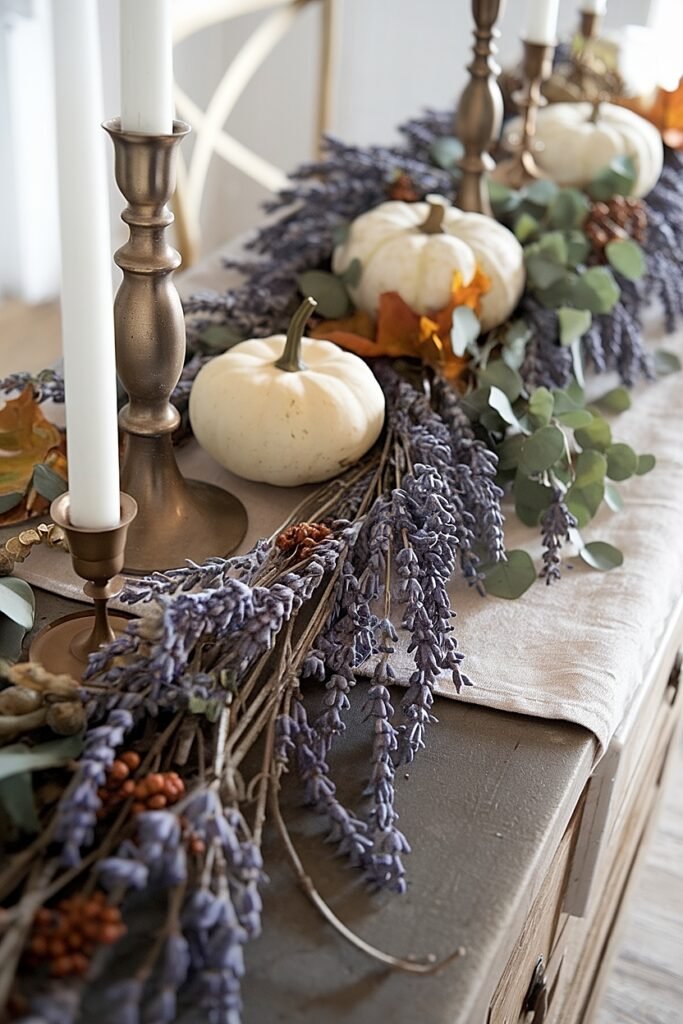
Sideboard garlands should be slimmer than dining-table versions. I twist a thin spine of lavandin and olive with paddle wire, then add short English lavender bundles every 10–12 inches for massed scent. Keep the profile under two inches high so platters glide above.
I weave micro-LEDs into the olive before adding lavender to avoid heat on buds. The wire battery pack hides under the medium pumpkin or behind a jar cluster. At each end of the garland, I tie a tiny velvet tail that matches napkin ribbons—a neat, deliberate finish.
Build a slim lavandin-olive line, light first, then add compact English bundles; finish ends with palette-matched ribbon tails. More organization ahead—keep reading to put rustic trays to work.
How to Pair Lavender with Rustic Wooden Trays on Thanksgiving Sideboards
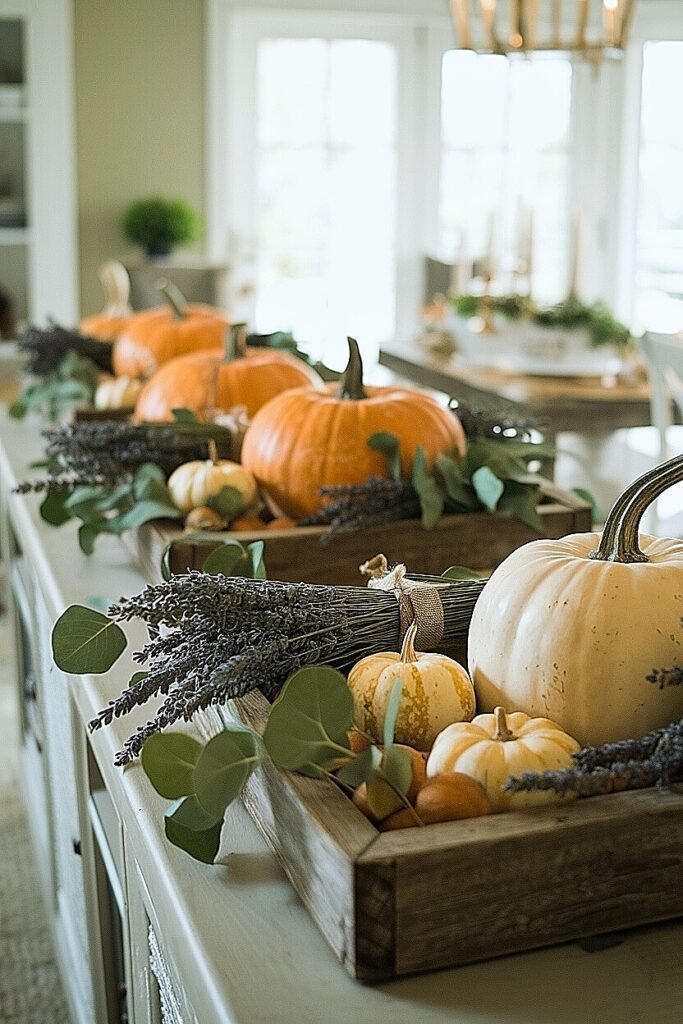
Trays create order. I use two: a large rectangle for jars and votives, and a smaller round for minis and fruit. The wood’s matte grain calms shine and protects the surface from drips. Inside each tray, I add a thin felt liner and a handful of olive leaves to soften the geometry.
For lavender, I tuck 3–4 stem tufts under jar lips and at the tray’s edge as quiet markers. This keeps scent present while leaving center space for function. The visual reads curated, not crafty, and cleanup becomes a single lift rather than a dozen trips.
Corral décor and light on wooden trays, soften edges with leaves, and tuck lavender in small, even beats around the perimeter. One last seasonal layer remains—keep reading to weave in autumn leaves with restraint.
Ways to Blend Lavender with Autumn Leaves on Thanksgiving Sideboards
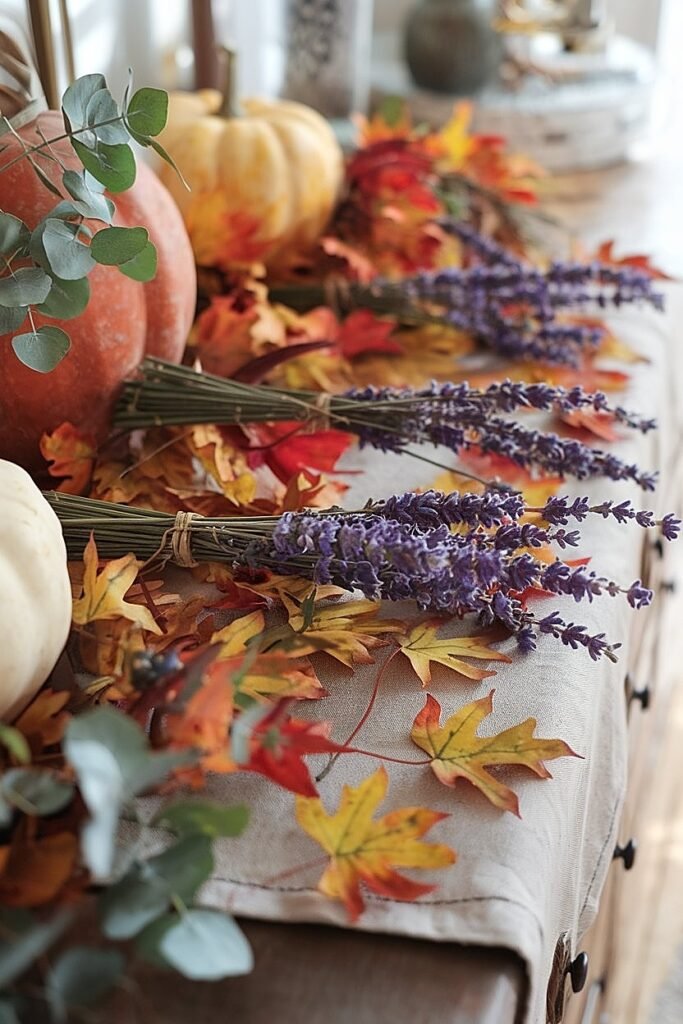
Autumn leaves can overwhelm if you pour them on. I curate. Pressed or preserved oak and maple leaves in muted tones (butter, rust, smoke) sit flat and behave. I scatter no more than seven, spaced like stepping stones that lead the eye from the anchor pumpkin to the jar cluster.
To integrate, I pin a tiny English lavender sprig atop select leaves with a dot of museum wax. This prevents drafts from flipping them and visually stitches the warm leaf tones to lavender’s coolness. If your palette leans modern, choose eucalyptus coin leaves instead for a sleeker read.
Use a handful of pressed leaves as visual guides, fix with museum wax, and bridge to lavender using tiny sprigs. There’s more nuance across the article—keep reading and adapt these moves to your room’s light and flow.
Conclusion
A thoughtful Thanksgiving sideboard earns its beauty through structure and restraint. Start with a matte runner, add a low bed of silver-green foliage, anchor with a single heirloom pumpkin, and stitch in short lavender bundles for quiet fragrance. Echo your table’s ribbon and metals, corral pieces on wooden trays, and punctuate with fruit and a few pressed leaves. Light it softly with mercury cups, hide your mechanics, and edit—always edit. Done well, the sideboard hums in harmony with your table and makes the whole room feel calm, generous, and unmistakably yours.
This website contains affiliate links, and some products are gifted by the brand to test. As an Amazon Associate, I earn from qualified purchases. Some of the content on this website was researched and created with the assistance of AI technology.
